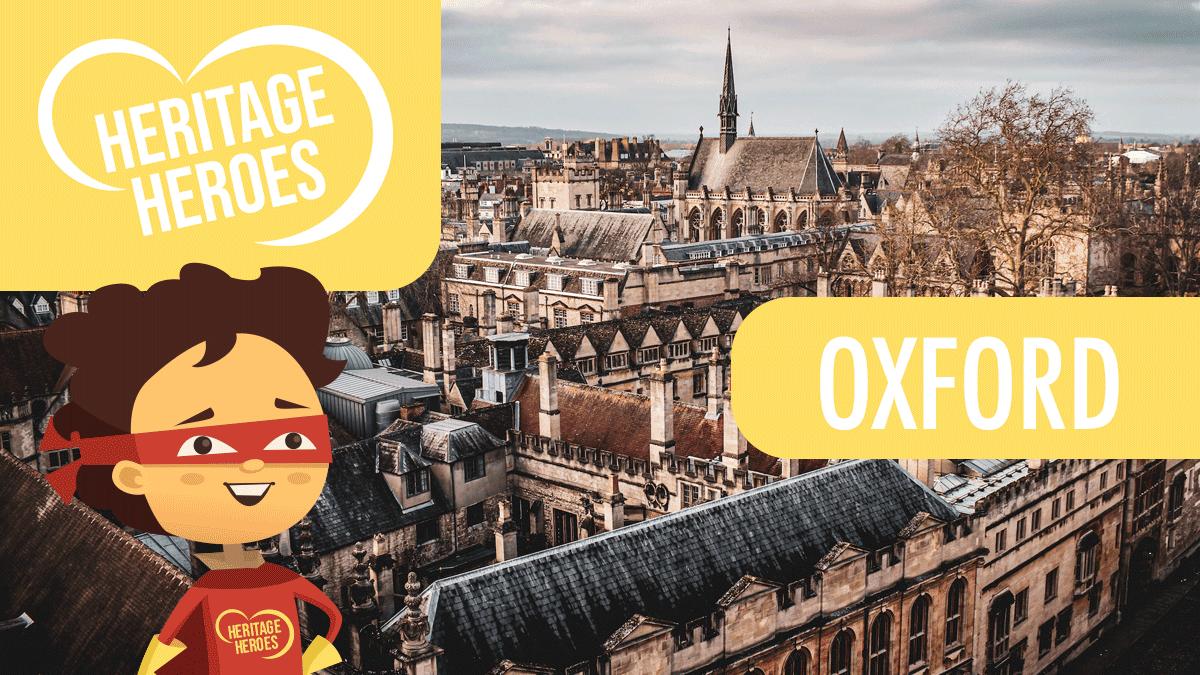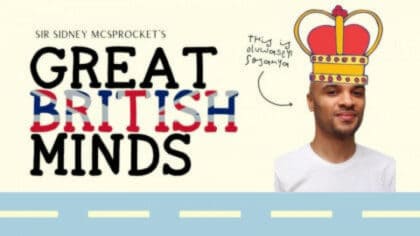Wherever you live, there’s treasure to be discovered! Not just gold and gems, but stories of buildings, locations and people.
Our heritage is a great wealth… and it’s all around us.
Sometimes standing proud in the open air, sometimes hidden behind some bushes.
To help find it, we asked for your help and to become Heritage Heroes.

HERITAGE HEROES. AN INSPIRING AUDIO PRODUCTION FOR FUN KIDS. MADE POSSIBLE WITH THE NATIONAL LOTTERY HERITAGE FUND, WITH THANKS TO NATIONAL LOTTERY PLAYERS.
Embed from Getty ImagesThe City of Oxford is north west of London and near the beautiful Cotswold Hills.
You might have heard it being called the City of Spires and if you visit it’s not difficult to see why!
It has a beautiful skyline of Gothic towers and steeples, most of which date from the 15th to 17th centuries and belong to Oxford University.
The Railway Station
The railway arrived in Oxford in 1844 when the Great Western Railway opened their line to a terminus station in Grandpont, which is just south of the River Thames.
When the railway opened on 14th June, there was great excitement. Large crowds gathered and celebrations went on late into the evening. Thousands watched the first train arrive.

In the 1850s, the Great Western Railway extended their line north to Banbury and onto Birmingham. At the same time, they built a new station on Botley Road.
Oxford station has always been busy, spreading its connections like tentacles. Lines came and went, including the Wycombe Railway, the Oxford, Witney & Fairford Railway, and the Blenheim & Woodstock Branch Line.

Oxford’s location meant it became an increasingly busy railway intersection, particularly for goods being carried north-south and east-west across the country.
To increase capacity, marshalling yards were opened where goods trains would drop off wagons, which were sorted according to destination before being picked up by another train.
It was so busy. There were twenty parallel tracks and capacity for 1,000 wagons!
Oxford’s History
Let’s head into the city and tell you some of Oxford’s history.
Oxford gets its name from the fact that during Saxon times it was a place where oxen once forded the Thames.
The city was founded in the 9th century when Alfred the Great created a network of fortified towns called burghs across his kingdom to defend the northern frontier of the kingdom of Wessex from Danish attack.
Yep, those pesky Vikings again!

In 1009, they burned Oxford, an easy task since all the buildings were of wood with thatched roofs.
Then in 1013, the Danish king claimed the throne of England. He invaded England and went to Oxford where ‘the people soon bowed to him and gave hostages’.
Embed from Getty ImagesOn a happier note, Saxon Oxford would have had a market from the time it was made a burgh and in the 10th century, Oxford even had a mint and 4 coin makers.
After the Normans invaded in 1066, Robert d’Oilly was appointed governor of Oxford. He set about to build Oxford Castle and a church tower.
Amazingly parts of the castle remain to this day as part of a visitor centre and you can explore for yourself.

The remains of Oxford Castle and its prison are a must see, although only St George’s Tower, the mound and the base of the Round Tower survived.
- “My heritage hotspot is Oxford Castle which was built for Wiliam the Conqueror in 1071. It’s interesting to see a really old building next to the modern ones”.
St George’s Tower is one of the earliest stone towers in England and a fun fact is that it wasn’t only common criminals who were held here in those early times. Even rebellious students might have found themselves locked up for being naughty!

In the English Civil War, Oxford’s strategic importance made the city the Royalist headquarters. In May 1646 Parliamentary forces besieged the city, which finally surrendered on 24th June.
In the 12th and 13th centuries, Oxford was becoming a manufacturing town, famous for its cloth and leather. There were many tanners in the town and leather workers such as shoemakers and saddlers.
Embed from Getty ImagesHowever, by the 15th century, manufacturing declined and the city became dependent on its students. Although it still remained a bustling town with brewers, butchers, bakers, tailors, shoemakers, coopers, carpenters and blacksmiths.
A really cool medieval building to see is at 24-26 Cornmarket Street.
- “My favourite time is medieval and you can see really cool medieval buildings in Cornmarket Street. 24 to 26 has got timber frames and was built in the 1300s for a wine merchant who ran it as an inn. There would have been lots of inns around here but not anymore”.

An interesting feature of many buildings from the 14th and 15th century is that they gradually become wider with every storey going up. This was a way of maximising floor space without needing to buy more land.
Sometimes with buildings like this on narrow streets, the overhang was so great that householders could reach out of a top-floor window and shake hands with their neighbours across the road!
Embed from Getty ImagesToday, whilst Oxford is best known as a university city, it also has a thriving industrial base.
In the early 20th century, William Morris opened his motor-car factory at Cowley, just outside the city, which for a while was the city’s largest employer.
Today that site is home to the MINI and you can take a tour around and see how cars are made.

Oxford also has many science and business parks that are affiliated with the university and are home to companies specialising in biotechnology and computer hardware and software.
The city is also home to printing and publishing… oh, and Frank Cooper’s marmalade!

Oxford University
As mentioned, Oxford is famous for its university, so it would be remise not to explore some of its heritage hotspots.
Embed from Getty ImagesFirst, let’s get the lowdown on the history of this iconic university. There’s 38 university colleges in total. Most of the colleges are behind big walls with large wooden gates to get in.
- “The University of Oxford is the oldest university in England. It comprises 38 colleges, each with its own history, income and regulations. The university also has its own police and its own courts. It disciplines students outside the walls of their own colleges. Each college is built around two or three quadrangles, or large lawns, with a chapel, hall, library, and walled gardens.“
No one knows exactly when the University of Oxford was founded. Legend says it was founded by the mythical King Memphric or by Alfred the Great, but the first record of it is in the late 1100s.

The university may have started after English students were banned from the University of Paris in 1168. By the year 1200 Oxford University had approximately 3,000 students from all over the world.
Embed from Getty ImagesIt can be interesting to take a walk around the colleges, each with its own history, income and regulations.
Plaques, Sundials & Decorations
Plaques, sundials and other decorations can often tell the history of the colleges themselves, and the famous people associated with them.

Outside the Botanic Garden between Danby Arch and the High Street is a little stone memorial that commemorates the work done in Oxford to make an antibiotic drug called penicillin. The scientist Alexander Fleming saw mould on one of his culture plates that killed bacteria, and that helped him get the idea to make penicillin.

In the Great Quad of All Souls College you can see another interesting heritage pick.
It’s a marvellous sundial that was designed by Christopher Wren. Whilst Wren is best remembered as an architect, in Oxford he was responsible for the Sheldonian and the Tom Tower in Christ Church. He was also a mathematician and astronomer.
Embed from Getty ImagesThe church of St Peter-in-the-East is now the college library of St Edmund Hall. On its south wall, to the left of the entrance, is a fine memorial to Jacob Bobart, who was the first keeper of the Botanical Gardens. Find out more about him later.
Make sure to check out the seed pods and flowers carved in the stone.

At Merton College, there’s an interesting sundial on the external wall of the chapel which was constructed in 1629, either by John Bainbridge, the first Savilian Professor of Astronomy, or by Henry Briggs, who was the first Savilian Professor of Geometry.

Whilst we’re at Merton College, check out the wall opposite the Savile memorial.
It’s a list of former Wardens of Merton College who include William Harvey who discovered the circulation of the blood. He was also physician to King Charles I.
Embed from Getty ImagesAnother interesting monument to see is one for Sir Thomas Bodley. He was a Greek lecturer who in 1587 married a wealthy widow and spent her money on the extension of Duke Humphrey’s library, collecting books from all over Europe.
Embed from Getty ImagesThe Bodleian Library
This library in Radcliffe Square is part of the Bodleian, which has been the University library since 1602.

Here’s what you told us:
- “The Bodleian Library was established on the 8th of November 1602. It was named after Thomas Bodleian. I’ve gone into the city centre a lot, I live in Cowley so I often pass through there to go to shopping and I always have a lot of fun. There are often a lot of tourists. My dad works at Wadham College and we have to pass through to get to the college so I generally spend a lot of time in Oxford. I really admire the building. I think it’s great that it’s really a library for the students of Oxford University and they can get any book whether it’s for studying or leisure. They can get most books from there.“
It’s a really impressive place!
The Radcliffe Camera
Nearby you can’t miss The Radcliffe Camera which was constructed between 1737 and 1747 and became part of the Bodleian in the 19th century.

Here’s a mind blowing fact!
They say the Bodleian contains over 3 million books and in the 1930s a tunnel was built to link the building with the new Bodleian on the other side of Broad Street.
Botanic Gardens
Heritage isn’t just confined to old buildings. Get outside and check out the Botanic Gardens.

These were founded by the Earl of Danby in 1621 as a physic garden, specifically for growing herbs and plants for use in medicine and science, and was built on the site of a medieval Jewish cemetery.
Whilst the high walls, which protect tender plants, were built when the garden opened, the layout of the beds dates from the mid-19th century.

The first keeper, Jacob Bobart, and after him his son, also called Jacob, kept the gardens for 78 years, building up an impressive plant collection.
Jacob the elder was an excellent gardener and botanist. He must have been quite a character, because on feast days he would decorate his long flowing beard with pieces of silver. He also kept a goat as a pet which you’d think would be a risky option for a gardener!
Look for this plaque when you visit!

James Sadler was the first English aeronaut. He was the son of a pastry cook and worked at the Ashmolean Museum before taking to the air and earning himself the title “The King of the Balloon”.
The plaque commemorates that flight in 1784. In October 1811 Sadler flew from Birmingham to Boston in Lincolnshire in under four hours. The following year he attempted to cross the Irish Sea and very nearly succeeded, having to ditch off Anglesey.
University Museum
Another impressive green space is the wide lawn of the University Museum. The building is impressive too, with its glass roof supported by ornate wrought ironwork.

The columns, made of different types of rocks found across the UK, have bases representing groups of animals and plants.
Check out the statues of famous scientists that line the walls!
On the same wall as the museum entrance is a large portrait of a dodo and the remains of a dodo that was exhibited alive in London in 1638 can be seen inside. Poor dodo!

Heritage is everywhere as we’ve been finding out. Not just in the grand buildings and gardens, but also in the places we go to every day.
We heard at the start of our adventure that Oxford has had a market for centuries and it’s a place you still enjoy exploring today.

You told us…
- “I’ve chosen the covered market which is basically a labyrinth full of shops. It was born in the 1770s, designed by John Gwynn who also designed Magdalen Bridge. It’s full of vibrant colours, nice smells and different people, that’s why I like it. It’s always fizzy with movement. It’s like having a different mini world of magic inside Oxford.“
- “I picked Penny Farthing place, which is not named after the bicycle as many people think but after a very early bailiff of Oxford who was called Mr Penny Farthing. There were also cross streets where we found two walls that had been built on the crossroads to divide the working-class houses from the upper-class houses. The rich didn’t want to mingle with the poor so they built walls in between their houses so they didn’t have to. The penny-farthing place was from the 17th century and the walls were built in 1934 and taken down in 1959. Well it’s important that we know where our street names are from and where they’ve originated because a lot of people live on these streets now and they don’t even give a second thought to where it’s from and the history of their street. It’s quite important for people’s heritage and how they look after their streets to make them proud of them.“
It’s not just buildings and people that shape a city. Rivers hold history too, bringing trade and transport, as well as being places to enjoy leisure time.

We heard from some of you who have memories of the rivers that run through Oxford…
- “The Thames is a river that runs through Oxford and it goes all the way to London. It’s actually the longest river in England. My house is basically right next to it. I also used to cycle along the river to get to school and things. It’s a very important part of lots of people’s lives and it has been for a long time. Like the place that we go. It’s like a canal, which would have been used for traveling, for boats to travel along and it was definitely a key part in the the Industrial Revolution and transporting things from one place to another. Also, obviously lots of places, lots of villages and towns and things were made because it was near the Thames and then they could use the water to do lots of different things like washing and traveling and all that kind of stuff.“
- “I’ve chosen to talk about the Cherwell River. It’s a river that flows throughout Cherwell and by my house. I’ve been going there ever since I was a little girl and it lives right down the road from me. I went punting there once. Punting is when you get a boat and then you get this really long pole and then you push up from the bottom. That’s how I got to school one day. It was the site of a major battle, the English Civil War in 1644. It’s quite interesting because it’s a water source for the wild horses in Port Meadow.“
Punting to school – how cool is that?
We had a great time exploring Oxford. Thank you for joining us!
There’s plenty more to explore here and across the country, wherever you live.
Don’t forget to go online to find out more about how to explore and record heritage in your area and of course, download your Heritage Hero certificate here.
Join us again to explore some more local heritage highlights and hotspots.









